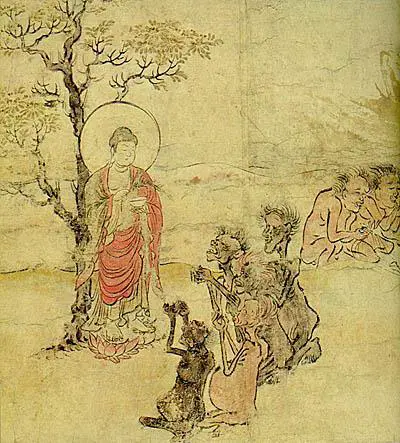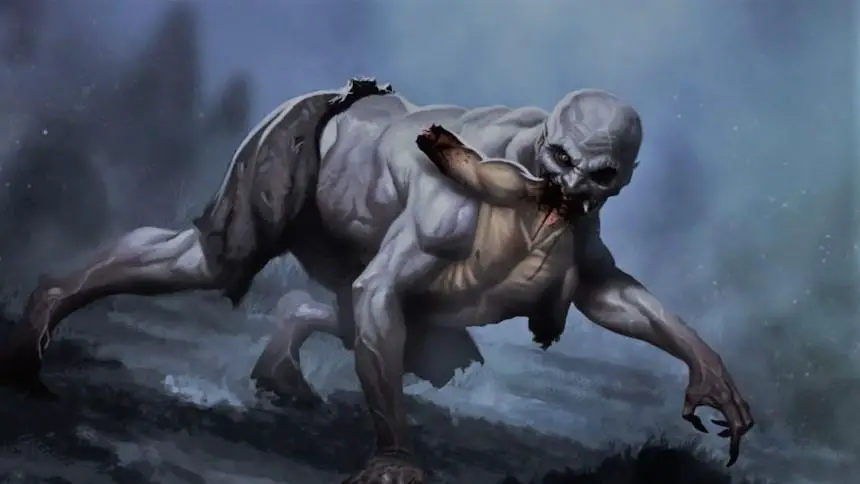Share the Lore!
By: Alex Postrado
People Eating Ghosts
Somewhere between the world of the living and the realm of the dead, a certain ghost-like entity from Japanese folklore is said to eternally wander.
Typically found in old houses, temples, and ruins, this being stays hidden during the day — invisible to the human eye, just as its dwelling.
But, when the night starts to creep in, unsuspecting travelers are sometimes granted a peek.
At first glance, the jikininki will only send shivers down the spine of whoever sees it. This is due to its off-putting appearance and putrid scent.
However, upon closer look, this revenant monster would immediately make anyone want to throw up!
In English, the word jikininki translates to “human-eating ghost“.
Yet, despite the name, the jikininki — as the story goes — only prefers to gorge on a specific kind of human.
And by that, I mean, dead human.
While eating corpses is the jikininki’s thing, if truth be told, they are not particularly delighted about it.
In fact, it is more of a curse to them than a chosen lifestyle.
And if you happen to be curious about how it all boiled down to this for Japan’s corpse-consuming zombies, then I recommend you read on.
What Are Jikininki?
In Japanese culture, there is a belief that if you spend your days living in greed and selfishness, all of your actions will one day come back to haunt you.
That is to say, in your death, you will turn into a jikininki.
Jikininki are basically the ghouls of Japanese folklore.
They are the souls of rapacious people, cursed to forever hunger for the flesh and bones of decaying human corpses.
They slip into temples at night — feasting on any interred bodies and robbing them of their valuables, including food and offerings.
It is also during these hours of darkness that jikininki would take on their real form.
A form that could easily freeze anyone in place once they see it!
In simpler words, jikininki look like some sort of ghost-like revenants.
They stand up hunched and have glowing yellow or red eyes, as well as razor-edged teeth and equally-sharp claws — both of which help them peel off the skins of their victims without much difficulty.
Moreover, it is believed that only little is left of their hair.
And their bodies — covered in infections, blisters, abrasions, and scars.
Some also note that jikininki — much like their diet of choice — are actually some sort of rotting corpses, themselves.
But, by day, they either disguise themselves as humans to blend in or avoid human contact altogether, making them — in their real form — practically invisible to normal people.
Jikininki’s inclination to keep their zombie-like form out of anyone’s sight stems from their feelings about their own selves.
More conspicuously, how they got into the horrendous spot they are currently in.
As regretful as it may sound, jikininki absolutely loathe their existence.
They feel disgusted about how they look and feel even more terrible about how they act.
But, as the lore puts it, jikininki are essentially slaves to their cravings. And, as much as they might want to do something about it, they could not possibly flee from their doom.
All that they could do is to temporarily relieve it.
Unfortunately, that would require them to have a taste at some moldering human flesh — which, in the end, only puts them in an endless cycle of a moment’s escape from eternal hunger to stages of self-contempt, then repeat.

Muso and the Jikininki
In Japan, there is a traditional folktale that is widely credited for making the lore jikininki famous countrywide.
Plainly titled, Jikininki — it tells the story of how a monk, named Musō Soseki, met an actual jikininki in one of his travels.
And the tale goes like this.
In the Mino province of Japan, quite a long time ago, a traveling monk, called Musō, lost his way in the mountains.
In his journey to find a way out, he suddenly came across an old Anjitsu — a residence known to house solitary priests — situated atop a nearby hill.
He carefully walked toward it to see if anybody was inside and could help him.
It was almost dark, anyway, and Musō thought to himself that a place to stay the night would surely sound great.
But, as he closed in, the man — an old priest — who solely inhabits the house, immediately refused to help him, telling him to seek shelter elsewhere, perhaps, in the small village close by.
So, Musō had no other option but to leave. Lucky for him, it was not long before he finally reached the village.
When he arrived, the headman politely welcomed and escorted him to a place where he could get a meal and take his good night’s rest.
Everything was going well for Musō until, sometime before midnight, a young man informed the monk of a recent death in the village — that of the man’s father.
He told Musō that the reason why he was only telling him about it was that he was afraid Musō might feel embarrassed or obligated to participate in the funeral ceremonies.
But, now, everybody is about to vacate the village for the night — as it was customary to leave the corpse alone to deter bad luck from befalling the village people — and he wanted to let Musō know about it.
Musō understood the man’s concern, but he also knew that, as a monk, he needs to perform his funeral duties and watch over the corpse throughout the night.
So, as the others left, he stayed — kneeling by the corpse to begin the service.
In the dead of night, when Musō was deep into his meditation, an ambiguous being entered the room.
The monk could neither move nor speak and he was forced to watch helplessly as the strange figure ate the corpse greedily, along with the offerings beside it.
The sun came up the next day and the corpse was gone.
Musō told the young man about the incident, but it did not surprise him. Instead, what caught his attention was Musō’s question about a certain priest in the Anjitsu close by.
The man contended that there was no such Anjitsu anywhere near and neither was a priest that they knew of.
Eventually, Musō left the village to continue his journey.
But, out of his curiosity, he first tried to seek out the Anjitsu one last time to confirm his prior experience.
There, he was met by the old priest who — this time around — let him in.
The priest apologized for what he did the night before at the funeral and revealed that he was — in fact — a jikininki.
The being who devoured the body, watched over by Musō!
He said that he was transformed into one after living a life of selfishness.
Unwilling to continue with his eternal doom, the priest pleaded with Musō to set him free of the curse through a segaki ritual.
Musō took pity on his situation and proceeded with the service.
The priest soon vanished, as with the Anjitsu — mysteriously leaving Musō atop a grassy hill, surrounded by temple ruins and in front of the priest’s tombstone.
Where the Story of the Corpse-Eating Monster Began
The tale of Musō and the jikininki was said to first appear in Lafcadio Hearn’s 1904 book, titled Kwaidan: Stories and Studies of Strange Things.
Considering the year of publication, some say that the story is something of a modern creation — especially when compared to other folktales that have been present since ancient times.

However, records suggest that most of the stories from Hearn’s work — including Jikininki — were actually derived and translated from original Japanese texts that date back to a far older time.
No one could be sure about how far back it actually goes, but it is assumed that the origin of jikininki somehow interlaces two important parts of Japanese culture:
Zen Buddhism and Japanese rural traditions.
Be it in Chinese Buddhism, Tibetan Buddhism, Vietnamese Buddhism, or Japanese Buddhism, there is a concept known as the “hungry ghosts“.
Otherwise called Gaki or Preta, they are said to be preternatural entities that are “riddled with powerful desires they can never really satisfy”.
Typically, these hungry ghosts are corpse-like figures, driven by animalistic instincts.
And the 26th class of them? Believed to be reserved for the jikininki!
These eternally-cursed, corpse-eating revenants, stirred into existence by Buddhist teachings, are clear warnings against self-serving and greed — values that are encouraged by material
desires.
Furthermore, this is where rural traditions also come in.
For a very long time, rural Japan has reflected their religious and spiritual beliefs into their local cultures.
And the Buddhism-rooted idea that “selfishness is the root of all evil” is likewise practiced in most of Japan’s rural areas.
So, the existence of jikininki in their folklore also served “the monstrification of materialism” — more so, the “denouncement of rural folk traditions”.
Interestingly, the jikininki proves to be a haunting way to give form to the age-old fear of losing both the Buddhist teachings, as well as the collective rural culture in the ever-changing world.
Existing as a cautionary tale about what is to come if we let greed and selfishness take over our lives.
References:
Jikininki - Yokai Monster Research: Jikininki The Jikininki Urban Legend Jikininki - All About Asia Jikininki - One Of Worst Mythological Demons The Fate of a Materialistic Buddhist: A Cultural Edition of "Jikininki" by Lafcadio Hearn
